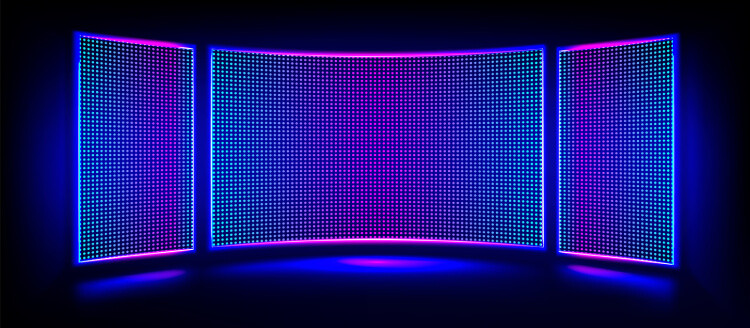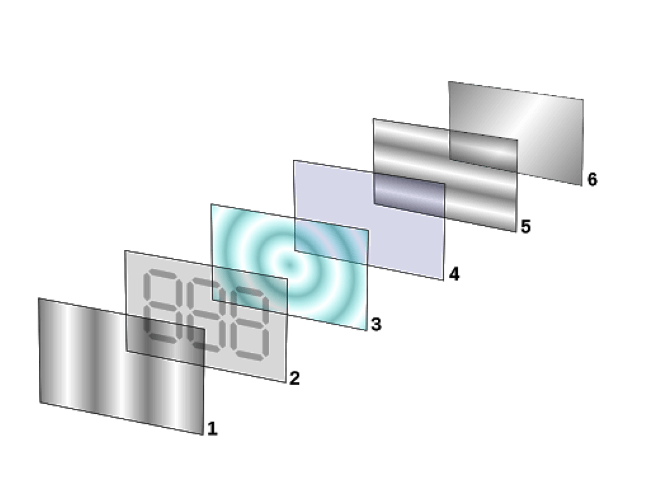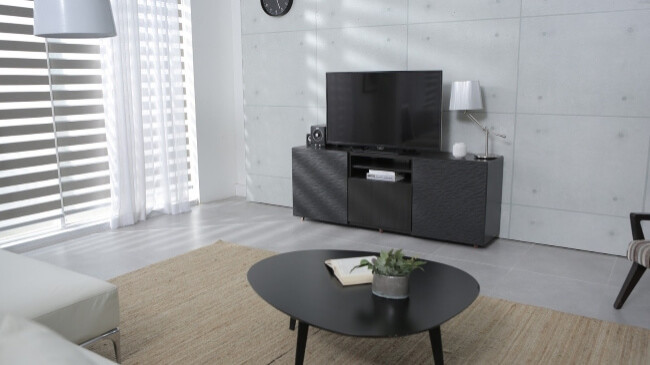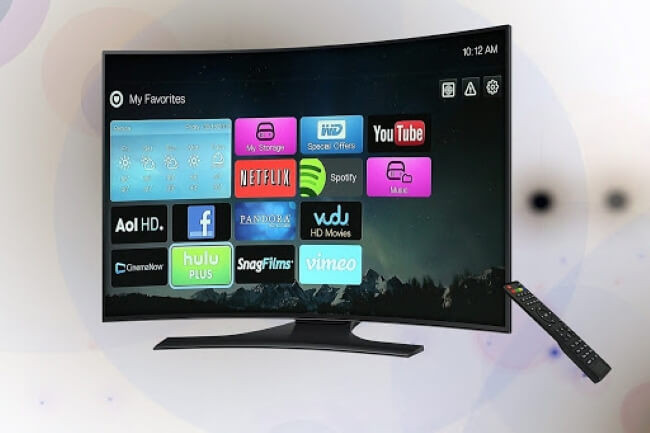LCD vs LED vs OLED vs TN vs IPS vs VA: A Breakdown of Display Technologies
| 07-07-2020 | By Moe Long

When it comes to display technologies such as projectors and panels, factors such as resolution and refresh rate are often discussed. But the underlying technology is equally, if not more, important. There are tons of different types of screens, from OLED and LED to TN, VA, and IPS. Learn about the various monitor and television types, from operation to pros and cons!
Table of Contents:
What is an LCD display (Liquid Crystal Display)?
The most common form of monitor or TV on the market is LCD or Liquid Crystal Display. As the name suggests, LCDs use liquid crystals that alter the light to generate a specific colour. So some form of backlighting is necessary. Often, it’s LED lighting. But there are multiple forms of backlighting.
LCDs have utilized CCFLs or cold cathode fluorescent lamps. An LCD panel lit with CCFL backlighting benefits from extremely uniform illumination for a pretty even level of brightness across the entire screen. However, this comes at the expense of picture quality. Unlike an LED TV, cold cathode fluorescent lamp LCD monitors lack dimming capabilities. Since the brightness level is even throughout the entire array, a darker portion of scenes might look overly lit or washed out. While that might not be as obvious in a room filled with ambient light, under ideal movie-watching conditions, or in a dark room, it’s noticeable. LED TVs have mostly replaced CCFL.
An LCD panel is transmissive rather than emissive. Composition depends on the specific form of LCD being used, but generally, pixels are made up of subpixel layers that comprise the RGB (red-green-blue) colour spectrum and control the light that passes through. A backlight is needed, and it’s usually LED for modern monitors.
LCD TV: Uses liquid crystals with some form of backlighting, either LED or CCFL
Pros:
- Lower cost compared to other technologies such as OLED or plasma
- Energy efficient, which can result in cost savings over time
- A wide range of sizes and resolutions are available
- Good colour reproduction and image quality
Cons:
- Limited lifespan
- Limited contrast ratio
- Limited motion handling
- May have limited HDR performance
Types of LED TVs:
- Edge-lit LED TVs
- Direct-lit LED TVs
- Full-Array LED TVs
- Micro-LED TVs
- QLED TVs (Quantum Dot LED TVs)
- OLED TVs (Organic Light Emitting Diode TVs)
- Mini-LED TVs
- Dynamic LED TVs
Please note that some of the mentioned types may be considered a sub-category of LCD TVs; therefore, some of the names may vary depending on the manufacturer and the market.

1) Film layer that polarizes light entering 2) glass substrate that dictates the dark shapes when the LCD screen is on 3) Liquid crystal layer 4) glass substrate that lines up with the horizontal filter 5) Horizontal film filter letting light through or blocking it 6) Reflective surface transmitting an image to the viewer
Image source: Wikipedia
What is an LED TV (Light Emitting Diode Television)?

While many newer TVs and monitors are marketed as LED TVs, it’s sort of the same as an LCD TV. Whereas LCD refers to a display type, LED points to the backlighting in liquid crystal display instead. As such, LED TV is a subset of LCD. Rather than CCFLs, LEDs are light-emitting diodes or semiconductor light sources which generate light when a current passes through.
LED TVs boast several different benefits. Physically, LED television tends to be slimmer than CCFL-based LCD panels, and viewing angles are generally better than on non-LED LCD monitors. So if you’re at an angle, the picture remains relatively clear nonetheless. LEDs are also extremely long-lasting as well as more energy-efficient. As such, you can expect a lengthy lifespan and low power draw. Chances are you’ll upgrade to a new telly, or an internal part will go out far before any LEDs cease functioning.
Ultimately, the choice between LED vs VA or any other display technology will depend on your specific needs and preferences, including things like size, resolution, brightness, and colour accuracy.
LED TV: A type of LCD panel that uses LED backlighting behind liquid crystals.
Pros:
- Long life span
- Great viewing angles
- Energy efficient
- LED TVs are smaller than CCFL LCD panels
Cons:
- Limited viewing angle
- Limited black levels
- Limited colour gamut
- High energy consumption
Types of LED TVs:
- Edge-lit LED TVs
- Direct-lit LED TVs
- Full-Array LED TVs
- Micro-LED TVs
- QLED TVs (Quantum Dot LED TVs)
- Mini-LED TVs
- Dynamic LED TVs
Please note that some of the mentioned types may be considered a sub-category of LED TVs; therefore, some of the names may vary depending on the manufacturer and the market.
What is a TN (Twisted Nematic) Panel?

Further segmenting LED TVs down, you'll find TN panels. A TN or twisted nematic display is a type of LED TV that offers a low-cost solution with a low response time and low input lag.
These displays are known for their high refresh rates, ranging from 100Hz to 144Hz or higher. As a result, many monitors marketed towards gamers feature TN technology. The fast response time and low input lag make them ideal for fast-paced action and gaming. However, TN panels have some limitations.
They suffer from inferior colour reproduction, meaning that the colours they display may be less accurate and vibrant than other technologies. Additionally, they have poor viewing angles, meaning the picture quality can degrade when viewed from certain angles. This is due to the way the liquid crystal molecules point at the viewer and the orientation of the light polarizers at 90-degree angles.
Overall, while TN panels are an affordable and fast option, they may not be the best choice for those looking for accurate colour reproduction and wide viewing angles.
TN display screen panel: A type of LED that uses twisted nematic liquid crystals.
Pros:
- Low-cost
- Fast: low response time and input, high refresh rate
- Great for gaming
Cons:
- Poor colour reproduction
- Bad viewing angles
Types of TN display screens:
- Twisted Nematic (TN) LCD panels
- Fast-switch TN LCD panels
- High-performance TN LCD panels
- Super-fast TN LCD panels
- Low-blue light TN LCD panels
- Wide-viewing angle TN LCD panels
What is an IPS display (In-Plane Switching)?

Like TN, IPS or In-plane Switching displays are a subset of LED panels. IPS monitors tend to boast accurate colour reproduction and great viewing angles. Price is higher than on TN monitors, but in-plane switching TVs generally feature a better picture when compared with twisted nematic sets. Latency and response time can be higher on IPS monitors meaning not all are ideal for gaming.
An IPS display aligns liquid crystals in parallel for lush colours. Polarizing filters have transmission axes aligned in the same direction. Because the electrode alignment differs from TN panels, black levels, viewing angles, and colour accuracy is much better. TN liquid crystals are perpendicular.
IPS monitor: In-plane switching is a type of LED monitor where liquid crystals line up in parallel rather than being at right angles.
Pros:
- Great viewing angles
- Accurate colour reproduction
- Great black levels
- Good colour consistency
- Good grey-scale performance
Cons:
- Slower pixel response time than TN
- Pricier than TN panels
- High energy consumption
Types of IPS monitors:
- In-Plane Switching (IPS) LCD monitors
- Super IPS (S-IPS) LCD monitors
- Advanced High-Performance In-Plane Switching (AH-IPS) LCD monitors
- Professional-grade IPS LCD monitors
- Wide-gamut IPS LCD monitors
- HDR IPS LCD monitors
- 4K/UHD IPS LCD monitors
- Curved IPS LCD monitors
What is a VA monitor (Vertical Alignment)?
A VA or vertical alignment monitor is a type of LED monitor that features excellent contrast ratios, colour reproduction, and viewing angles. This is achieved by using crystals that are perpendicular to the polarizers at right angles, similar to the technology used in TN monitors. VA monitors are known for their deep blacks and vibrant colours, making them popular for media consumption and gaming.
They also have better viewing angles than TN monitors, meaning that the picture quality remains consistent when viewed from different angles. However, the response time of a VA monitor is not as fast as that of a TN monitor, which can be a concern for those looking to use the monitor for fast-paced action or gaming.
The pricing of VA monitors varies, but they are typically more expensive than TN monitors and less costly than IPS or OLED monitors. Overall, VA monitors are an excellent option for those looking for a balance between good picture quality and affordability.
VA panel: Vertical alignment, polarizers are perpendicular to crystals.
Pros:
- Great viewing angles
- Excellent colour accuracy
- Wonderful contrast ratio
Cons:
- Slower response time than TN
- Limited motion handling
- May have limited HDR performance
Types of VA panels:
- Vertical Alignment (VA) LCD panels
- High-contrast VA LCD panels
- High-performance VA LCD panels
- Super-fast VA LCD panels
- Low-blue light VA LCD panels
- Low-latency VA LCD panels
What is a Quantum Dot TV (QD-TV)?
A quantum dot LED TV or QLED is yet another form of LED television. But it’s drastically different from other LED variants. Whereas most LED panels use a white backlight, quantum dot televisions opt for blue lights. In front of these blue LEDs sits a thin layer of quantum dots. These quantum dots in a screen glow at specific wavelengths of colour, either red, green, or blue, therefore comprising the entire RGB (red-green-blue) colour spectrum required to create a colour TV image.
QLED TV sets are thus able to achieve many more local dimming zones than other LED TVs. As opposed to uniform backlighting, local dimming zones can vary backlighting into zones for adjustable lighting to show accurate light and dark scenes. Quantum Dot displays maintain an excellent, bright image with precise colour reproduction.
Quantum Dot TV (QD-TV): A type of television that uses quantum dots, also known as semiconductor nanocrystals, to produce more accurate and vibrant colours.
Pros:
- Affordable
- More local dimming zones than other LED TV varieties
- Quantum Dots sit in front of blue LEDs
- Bright image
- Great colour reproduction
Cons:
- More expensive than other LED display types
- Limited availability
Types of Quantum Dot TVs:
- QD-OLED TVs
- QD-LED TVs
- QD-LCD TVs
- QD-QLED TVs
- QD-UHD TVs
- QD-SUHD TVs
- QD-8K TVs
- QD-Curved TVs
- QD-Smart TVs
- QD-FALD (Full Array Local Dimming) TVs
Please note that some of the mentioned types may be considered a sub-category of Quantum Dot TVs; therefore, some of the names may vary depending on the manufacturer and the market. Also, it's worth mentioning that not all brands use the same technology. Some are using QD films or QD-LEDs, others are using QD-OLEDs, and the list could go on.
What is an OLED Display (Organic Light-Emitting Diode)?

An OLED or organic light-emitting diode display isn’t another variation of LED. OLEDs use negatively and positively charged ions for illuminating individual pixels. By contrast, LCD/LED TVs use a backlight that can make an unwanted glow. In OLED display, there are several layers, including a substrate, an anode, a hole injection layer, a hole transport layer, an emissive layer, a blocking layer, an electron transport layer, and a cathode. The emissive layer, comprised of an electroluminescent layer of film, is nestled between an electron-injecting cathode and an electron removal layer, the anode. OLEDs benefit from darker blacks and eschew any unwanted screen glow. Because OLED panels are made up of millions of individual subpixels, the pixels themselves emit light, and it’s, therefore, an emissive display as opposed to a transmissive technology like LCD/LED panels where a backlight is required behind the pixels themselves.
The image quality is top-notch. OLED TVs feature superb local dimming capabilities. The contrast ratio is unrivalled, even by the best of QLEDs, since pixels not used may be turned off. There’s no light bleed, black levels are incredible, excellent screen uniformity, and viewing angles don’t degrade the picture. Unfortunately, this comes at a cost. OLEDs are pricey, and the image isn’t as bright overall when compared to LED panels. For viewing in a darkened room, that’s fine, but ambient lighting isn’t ideal for OLED use.
OLED: Organic light-emitting diode display, non-LED. Emissive technology is where negatively and positively charged ions illuminate individual pixels in a display.
Pros:
- Excellent image quality
- Great screen uniformity
- No light bleed whatsoever.
- Lacks a backlight, emissive rather than transmissive technology
- Non-LED display
- Lifelike image
- Deep, dark blacks
- Viewing angles don’t degrade the picture.
Cons:
- Pricey
- Don’t get as bright as LED TVs
- Can suffer from burn-in
Types of OLED displays:
- OLED TV
- OLED monitor
- OLED laptop display
- OLED smartphone display
- OLED tablet display
- OLED e-reader display
- OLED wearable display
- OLED automotive display
- OLED digital signage display
- OLED flexible display
Please note that OLED technology can be applied to various displays and devices, and the list mentioned above may not be exhaustive. Also, some types may be considered a sub-category of OLED.
LED vs LCD vs IPS vs TN vs VA vs QLED vs OLED: In Summary
As you can see, a wide variety of displays are available on the market today, each with their unique advantages and disadvantages. While many monitors and TVs are referred to by various names, such as LED, IPS, VA, TN, or QLED, many are variations of LCD panels. The specific technology used in a display, such as the colour of backlighting and the alignment of pixels, plays a major role in determining the overall picture quality.
When choosing the right type of monitor or display for your needs, it's important to consider all the options available and weigh the pros and cons of each one. This can include things like resolution, refresh rate, response time, colour accuracy, and more subjective factors like overall picture quality and viewing angles.
LCD is the most common type and uses liquid crystals and either LED or CCFL backlighting. LED TVs are a subset of LCD panels with LED backlighting. TN panels offer a low-cost solution with low response time and input lag, while IPS monitors provide superior colour accuracy and wide viewing angles. VA panels have higher contrast ratios than IPS, but limited viewing angles and OLED TVs offer excellent colour accuracy, infinite contrast ratio, and superior motion handling. QLED TVs use quantum dots to enhance colour accuracy and brightness, making them great for bright rooms.
Now that you better understand the various display technologies available, you can make a more informed decision when selecting the best display to fit your needs. Ultimately, the choice depends on specific needs and preferences, including size, resolution, brightness, and colour accuracy.
So, what panels do you prefer?


